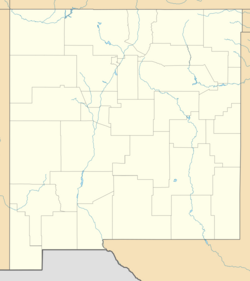Earth:Bell Ranch Formation
| Bell Ranch Formation Stratigraphic range: Kimmeridgian ~155–151 Ma | |
|---|---|
| Type | Geological formation |
| Unit of | San Rafael Group |
| Underlies | Morrison Formation |
| Overlies | Exeter Sandstone |
| Thickness | 66 feet (20 m) |
| Lithology | |
| Primary | Sandstone |
| Other | Siltstone |
| Location | |
| Coordinates | [ ⚑ ] : 35°18′14″N 103°53′12″W / 35.3040°N 103.8867°W |
| Paleocoordinates | [ ⚑ ] 31°30′N 49°42′W / 31.5°N 49.7°W |
| Region | New Mexico Oklahoma |
| Country | |
| Type section | |
| Named for | Bell Ranch |
| Named by | Griggs and Read |
| Year defined | 1959 |
The Bell Ranch Formation is a Late Jurassic (Kimmeridgian) geologic formation in eastern and northeastern New Mexico and the western Oklahoma panhandle. Fossil theropod tracks have been reported from the formation.[1][2]
Description
At the type section near Tucumcari, the formation consists of alternating beds of light gray sandstone and brownish red siltstone. Bed thicknesses vary from 2–10 feet (0.61–3.05 m), distinguishing the unit from the massive sandstone of the underlying Exeter Sandstone and poorly bedded sediments of the overlying Morrison Formation. Small gypsum nodules are present in the upper beds. Thickness is up to 66 feet (20 m).[3] Further north, in the valley of the Dry Cimarron, the facies changes to dark mudstone with no cycles and more abundant gypsum. Here the thickness is no more than 8 meters (26 ft).[4]
Fossil content
The formation contains sandy track beds which are "mud-cracked" with finer brownish silty interbeds and an overlying conglomeratic sandstone which fills the mudcracks of the upper bed.[5] Three trackways of large dinosaurs are present.[2]
- Ichnofossils
- Grallator (Eubrontes)
- cf. Gypsichnites sp.
History of investigation
The beds making up the unit were originally assigned to the Wanakah Formation, but were renamed by Griggs and Read in 1959 for exposures at Carpenter's Point, 13 miles (21 km) northwest of Tucumcari.[3] The correlation with the Wanakah is uncertain.[6] In 1987, Conrad et al. correlated the "brown-silt member" assigned by Baldwin and Muehlberger to the Morrison Formation in the valley of the Dry Cimarron[7] to the Bell Ranch Formation.[2]
In 1992, Anderson and Lucas advocated abandoning the Bell Ranch Formation in favor of the Summerville Formation.[8] However, this has not be universally accepted.[4]
See also
- List of dinosaur-bearing rock formations
- List of stratigraphic units with theropod tracks
References
Bibliography
- "Carrizo tracksite". Fossilworks.org. http://www.fossilworks.org/cgi-bin/bridge.pl?a=collectionSearch&collection_no=92285.
- Ziegler, Kate E.; Ramos, Frank C.; Zimmerer, Matthew J. (2019). "Geology of Northeastern New Mexico, union and Colfax Counties, New Mexico: A Geologic Summary". New Mexico Geological Society Field Conference Series 70 (4): 47–54. https://nmgs.nmt.edu/publications/guidebooks/downloads/70/70_p0047_p0054.pdf. Retrieved 1 September 2020.
- The Dinosauria, 2nd edition. Berkeley: University of California Press. 2004. pp. 1–880. ISBN 0-520-24209-2. https://books.google.com/books?id=vtZFDb_iw40C. Retrieved 2019-02-21.
- Anderson, O.J.; Lucas, Spencer G. (November 1992). "The Middle Jurassic Summeruille Formation, northern New Mexico". New Mexico Geology 14 (4): 79–92. https://geoinfo.nmt.edu/publications/periodicals/nmg/14/n4/nmg_v14_n4_p79.pdf. Retrieved 2 September 2020.
- Conrad, Kelly; Lockley, Martin G.; Prince, Nancy K. (1987). "Triassic and Jurassic vertebrate-dominated trace fossil assemblages of the Cimarron Valley region--Implications for paleoecology and biostratigraphy". New Mexico Geological Society Field Conference Series 38: 127–138. https://nmgs.nmt.edu/publications/guidebooks/downloads/38/38_p0127_p0138.pdf. Retrieved 1 September 2020.
- Scott, G.R. (1986). "Geologic and structure contour map of the Springer 30' x 60' quadrangle, Colfax, Harding, Mora, and Union Counties, New Mexico". U.S. Geological Survey Miscellaneous Investigations Series Map I-1705. http://ngmdb.usgs.gov/Prodesc/proddesc_9890.htm. Retrieved 2 September 2020.
- Griggs, R.L.; Read, C.B. (1959). "Revisions in Stratigraphic Nomenclature in Tucumcari-Sabinoso Area, Northeastern New Mexico: GEOLOGICAL NOTES". AAPG Bulletin 43. doi:10.1306/0BDA5E8E-16BD-11D7-8645000102C1865D.
- Baldwin, Brewster; Muehlberger, W.R. (1959). "Geologic studies of Union County, New Mexico". New Mexico Bureau of Mines and Mineral Resources Bulletin 63 (2). https://geoinfo.nmt.edu/publications/monographs/bulletins/downloads/63/Bulletin63.pdf. Retrieved 1 September 2020.
Further reading
- Lockley, M. G (1986). "A Guide to Dinosaur Tracksites of the Colorado Plateau and American Southwest". University of Colorado at Denver Geology Department Magazine 1: 1–56.
 |



